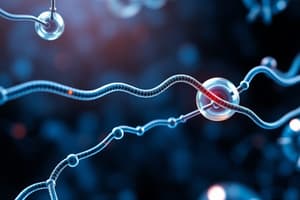Podcast
Questions and Answers
Which condition would lead to a decrease in the rate of a chemical reaction?
Which condition would lead to a decrease in the rate of a chemical reaction?
- Decreased temperature (correct)
- Increased concentration of reactants
- Higher pH level
- Increased pressure
What occurs when a chemical reaction is at equilibrium?
What occurs when a chemical reaction is at equilibrium?
- The reaction can no longer proceed in either direction.
- The rates of the forward and reverse reactions are equal. (correct)
- The free energy of products is less than that of reactants.
- The concentration of reactants is zero.
According to the Gibbs Free Energy equation, when will a reaction be spontaneous?
According to the Gibbs Free Energy equation, when will a reaction be spontaneous?
- When ΔS is negative.
- When ΔH is negative.
- When ΔG is negative. (correct)
- When ΔG is positive.
Which of the following statements regarding activation energy (EA) is true?
Which of the following statements regarding activation energy (EA) is true?
Which scenario represents an endergonic reaction based on Gibbs Free Energy?
Which scenario represents an endergonic reaction based on Gibbs Free Energy?
What primarily occurs during catabolic pathways in metabolism?
What primarily occurs during catabolic pathways in metabolism?
Which of the following is NOT a direct product of catabolic pathways?
Which of the following is NOT a direct product of catabolic pathways?
What is the correct sequence of stages in energy metabolism?
What is the correct sequence of stages in energy metabolism?
Which statement best describes a reducing agent in oxidation-reduction reactions?
Which statement best describes a reducing agent in oxidation-reduction reactions?
In metabolic processes, NAD+ can be described as?
In metabolic processes, NAD+ can be described as?
What is the main purpose of anabolic pathways in metabolism?
What is the main purpose of anabolic pathways in metabolism?
What term describes the reaction type where a substrate loses electrons?
What term describes the reaction type where a substrate loses electrons?
Which pairs of terms correctly define the roles of oxidizing and reducing agents?
Which pairs of terms correctly define the roles of oxidizing and reducing agents?
What effect do enzymes have on the activation energy (EA) of reactions?
What effect do enzymes have on the activation energy (EA) of reactions?
Which of the following is NOT a characteristic of enzymes?
Which of the following is NOT a characteristic of enzymes?
Which factor is NOT dependent on the rate of chemical reactions?
Which factor is NOT dependent on the rate of chemical reactions?
What role do coenzymes play in enzyme function?
What role do coenzymes play in enzyme function?
In which of the following proteins does the enzyme pyruvate dehydrogenase operate?
In which of the following proteins does the enzyme pyruvate dehydrogenase operate?
Which of the following correctly describes free energy ($,G$) in glycolysis?
Which of the following correctly describes free energy ($,G$) in glycolysis?
What type of non-protein component is a metal ion cofactor considered?
What type of non-protein component is a metal ion cofactor considered?
Which of the following is the primary function of enzymes in biochemical reactions?
Which of the following is the primary function of enzymes in biochemical reactions?
What is the consequence of altering temperature, pressure, or pH on chemical reactions?
What is the consequence of altering temperature, pressure, or pH on chemical reactions?
What is the effect of phosphorylation on the activity of the enzyme involved in the conversion of pyruvate?
What is the effect of phosphorylation on the activity of the enzyme involved in the conversion of pyruvate?
Which process does an enzyme facilitate in a chemical reaction?
Which process does an enzyme facilitate in a chemical reaction?
In the context of enzyme kinetics, what is the significance of the transition state?
In the context of enzyme kinetics, what is the significance of the transition state?
What does the equation ΔG = ΔH – (T x ΔS) represent?
What does the equation ΔG = ΔH – (T x ΔS) represent?
How does increasing temperature affect the rate of an enzyme-catalyzed reaction?
How does increasing temperature affect the rate of an enzyme-catalyzed reaction?
What is the primary role of an enzyme in the formation of an enzyme-substrate (ES) complex?
What is the primary role of an enzyme in the formation of an enzyme-substrate (ES) complex?
What change occurs in an enzyme when it converts substrates into products?
What change occurs in an enzyme when it converts substrates into products?
Which of the following is true regarding activation energy and catalysts?
Which of the following is true regarding activation energy and catalysts?
Which reaction is considered favorable based on the free energy changes provided?
Which reaction is considered favorable based on the free energy changes provided?
What characterizes the inactivation of an enzyme by phosphorylation?
What characterizes the inactivation of an enzyme by phosphorylation?
Which type of macromolecule is primarily responsible for energy storage in the form of fats?
Which type of macromolecule is primarily responsible for energy storage in the form of fats?
Which characteristic distinguishes RNA from DNA in terms of structure?
Which characteristic distinguishes RNA from DNA in terms of structure?
Which type of macromolecule does NOT typically act as a catalyst in biochemical reactions?
Which type of macromolecule does NOT typically act as a catalyst in biochemical reactions?
Which amino acid is classified as nonpolar and is essential for various biological functions?
Which amino acid is classified as nonpolar and is essential for various biological functions?
What is the primary role of enzymes within a cell?
What is the primary role of enzymes within a cell?
What conclusion can be made regarding the bonding characteristics of polar charged amino acids?
What conclusion can be made regarding the bonding characteristics of polar charged amino acids?
Which of the following statements is true about amino acids like hydroxylysine?
Which of the following statements is true about amino acids like hydroxylysine?
What best describes the concept of bioenergetics?
What best describes the concept of bioenergetics?
In the context of metabolism, which statement about thermodynamics is true?
In the context of metabolism, which statement about thermodynamics is true?
Which characteristic of enzymes contributes to their specificity?
Which characteristic of enzymes contributes to their specificity?
Flashcards are hidden until you start studying
Study Notes
Bioenergetics
- Bioenergetics is the study of energy transformations in a living organism.
- Energy is the capacity to do work, which is the change or movement of things.
- Thermodynamics is the study of energy changes.
- A cell needs to acquire and expend energy to function and stay alive.
Gibbs Free Energy
- Gibbs Free Energy (ΔG) represents the maximum amount of work a system can perform at constant temperature and pressure.
- It is also known as available energy and can be used to predict the spontaneity of a chemical reaction or process.
- The Gibbs Free Energy equation is: ΔG = ΔH – (T x ΔS)
- ΔH is the change in enthalpy (heat content), which is the sum of internal energy (E) and the product of pressure (P) and volume (V) of a thermodynamic system
- T is temperature in Kelvin.
- ΔS is entropy (the degree of disorder or randomness in a system).
Gibbs Free Energy Applications
- If a system is at equilibrium ΔG=0.
- If ΔG is negative, the reaction is exergonic and proceeds spontaneously toward a state of lower energy.
- If ΔG is positive, the reaction is endergonic and requires energy input or coupling.
- Activation Energy (EA) determines the rate of a reaction. A higher activation energy means a slower reaction rate.
Rates of Chemical Reactions
- All chemical reactions are theoretically reversible.
- The rate of a chemical reaction is proportional to the concentration of reactants and can be affected by:
- Temperature
- pH
- Pressure
- Location within a cell
- All chemical reactions spontaneously proceed toward equilibrium.
- At equilibrium, the free energies of products and reactants are equal.
- The equilibrium constant (Keq) approaches infinity in some situations where reactions are strongly favored in one direction. For example, burning wood (cellulose) is essentially irreversible.
Oxidation-Reduction Reactions
- Oxidation-reduction reactions involve a change in the electron numbers of reactants.
- GER= Gain of Electrons is Reduction
- LEO= Loss of Electrons is Oxidation
- Oxidation-reduction reactions are essential in metabolism.
- Electrons must be donated/accepted from other molecules
- Electron gaining molecule is the Oxidizing Agent
- Electron donating molecule is the Reducing Agent
Studying That Suits You
Use AI to generate personalized quizzes and flashcards to suit your learning preferences.




